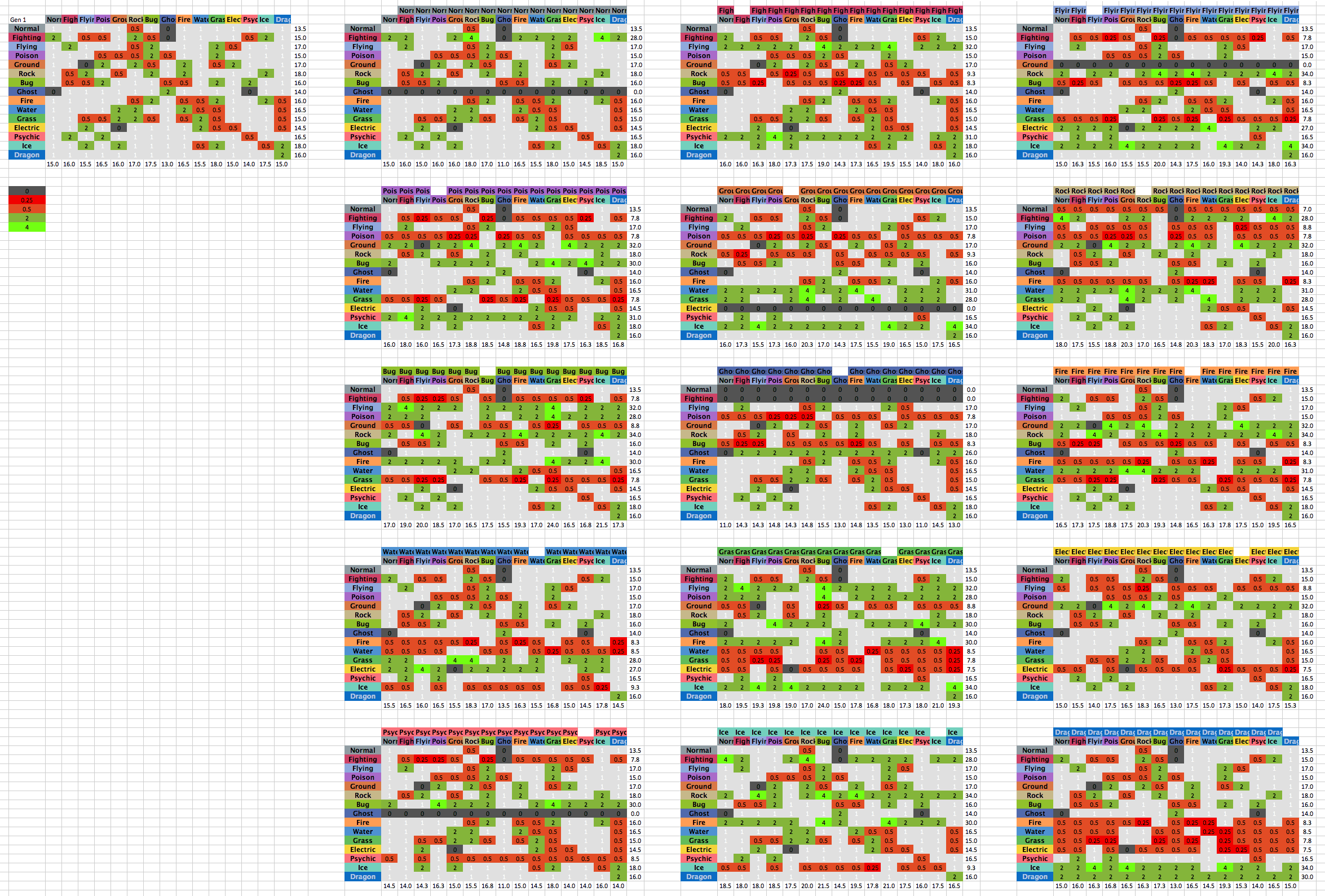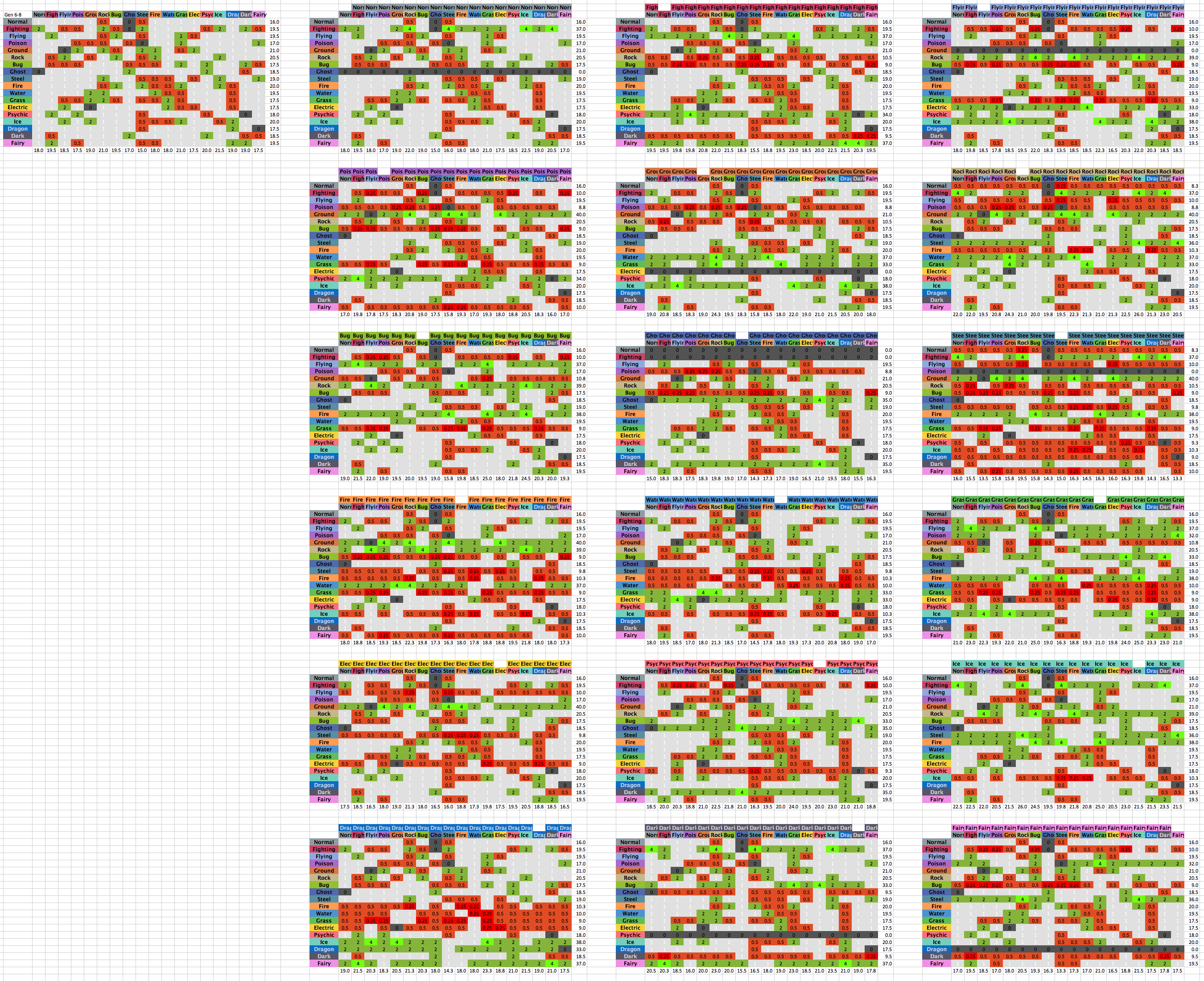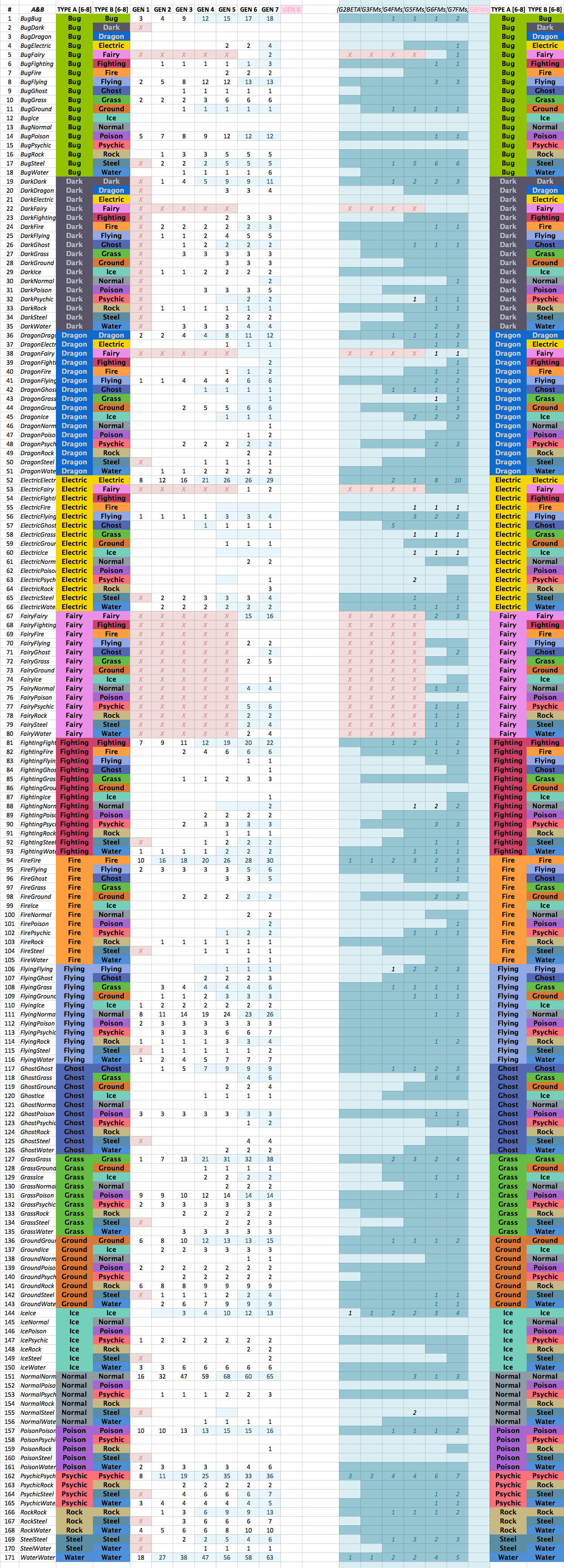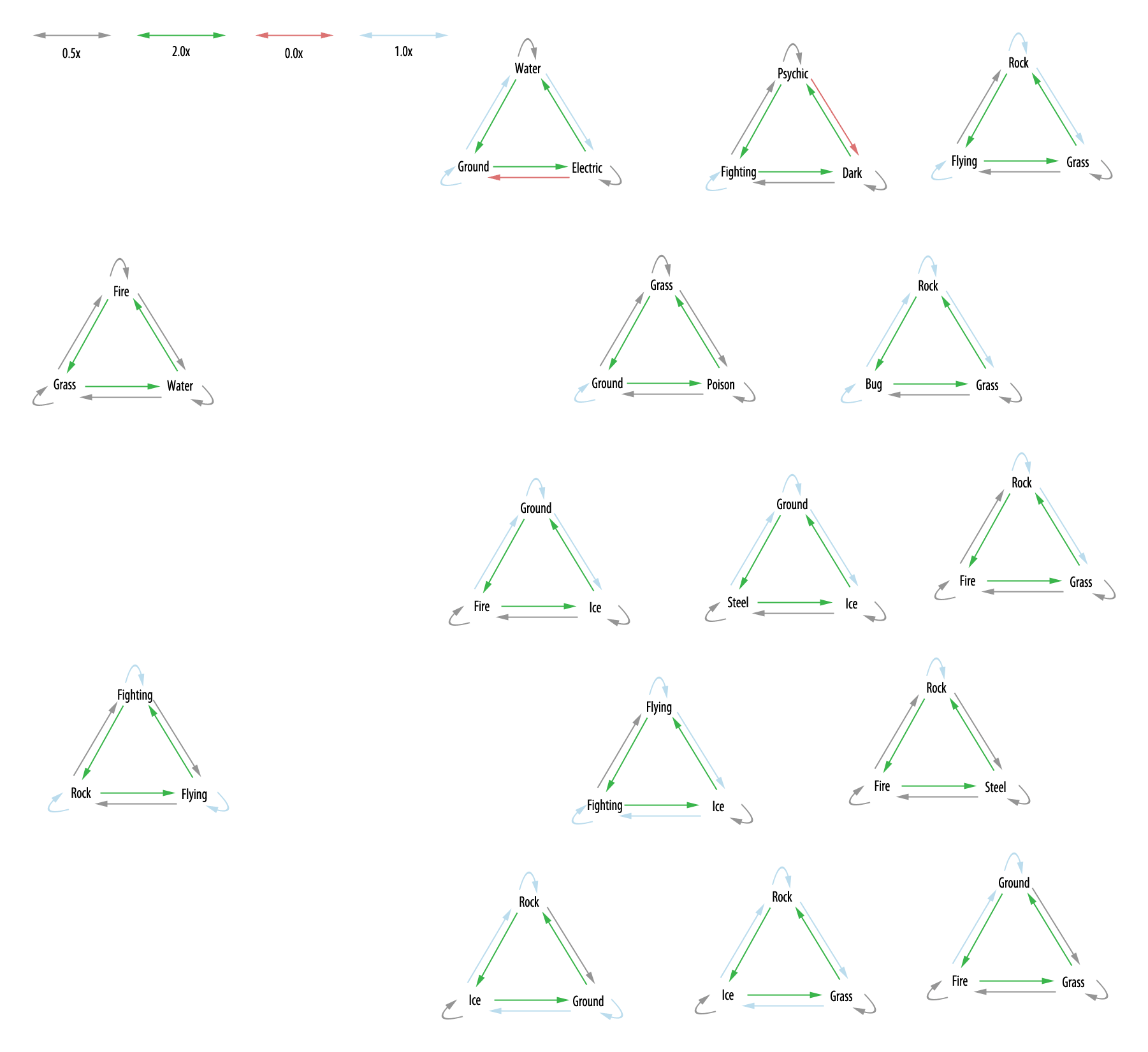Back during Gen 5 and Pokémon Black & White, I made a little chart in Excel where I combined the damage multiplier data for two Pokémon types and then used that data to determine which type combinations were the most weak or most resistant to type-related damage, assuming everything else was equal.
- (Long story short, Ghost-Steel was the most resistant to attacks, while Ice-Rock was weakest to the most types.)
However, that data was only accurate for Gens 2-5, seeing as it included Dark and Steel type, but didn’t cover the Fairy-type that was added in Gen 6. Not to mention the various type damage readjustments. And so here it is; you can also click on them to get a more detailed look.
The changes between each Gen really isn’t THAT much, but it does change a few things between each gen… particularly which type combinations are the most resistant or weak to attacks.
Oh also, the numbers at the bottom and right-side of each chart box are the type multipliers added together in order to get a single number which represents that type’s quality. Smaller number is better; obviously a type which takes only 0.5x damage from all other types is better than a type where each type’s attacks to 2x damage. Knowing this, here’s some perspective about what would be good or bad numbers.
- GEN 1 — with 15 types, a score of 15 would be average, meaning that each type, on average, does 1x damage to that type. Anything lower is better, and higher is worse.
- GEN 2-5 — 17 types means 17 points is average
- GEN 6-8 — 18 types = 18 points
Now obviously 17 points in Gen 1 is technically worse than 17 points in Gen 6-8. So to get an idea of what the scores in one era would translate to in another, that data is in the charts below. These you’ll definitely need to click in order to see them.
Again, since different numbers mean slightly different qualities in different gens, the charts thus include four different columns in order to make point comparisons easier. The columns mean:
- RAW — the actual data, divided by the number of types in that gen, thus generating a percentage.
- 15 — the percentage multiplied by 15
- 17 — multiplied by 17
- 18 — multiplied by 49.3 … …ok 18.
OK so what are the best and worst types for Gen 1 and Gen 6-8?
- GEN 1
- Best = Ghost-Normal and Ghost-Psychic (tied); however technically Psychic- and Electric-Flying types are the most resistant, at least of the types which actually appear in the game. Color me shocked.
- Worst = Bug-Grass (by a WIDE margin) … see? How you have actual proof that Caterpie is awful!
- GEN 6-8
- Best = Fairy-Steel; so I guess that makes Mawile a pain in the ass to KO, huh?
- Worst = Ice-Rock as well; thus making Aurorus the weakest Pokémon… well, type-wise.
It’s worth pointing out that the Ghost-Steel type from Gens 2-5 is overall THE strongest Pokémon type across all three type eras—scoring a 69.12% resistance versus Gen 1’s Ghost-Normal/Psychic’s 73.33% and 73.61% for Gen 6-8’s Fairy-Steel—while Gen 1’s Bug-Grass type is the ABSOLUTE WORST type combination—scoring 160% versus Ice-Rock’s Ice-Rock 147.06% during Gen 2-5 and 144.44 in Gens 6-8.
…
Jeez, and I still haven’t gotten to the last chart! OK, so let’s just fast forward through this part.
Every gen has a set of Pokémon of a certain type. This chard covers each generation and each type that was in it, as well as each type that WASN’T in it. Like everything else, you can click on it to get a zoomed in view.
One thing that I did with this was keep the number of regular Pokémon types separate from Pokémon with formes. So the values on the left are the number of normal Pokémon with those types; these values also regional forms (Alolan Meowth, etc) which can be found in the wild and/or evolve normally from a normal Pokémon and are therefore considered just as official. Meanwhile, the values on the right are the number of special Pokémon with those types, such as the aforementioned formes (which I consider different from regional types as they’re either temporary or conditional), as well as PokéWood “Stars” which had their own unique typing. I’ve even included Beta Pokémon (such as ones from the Space World 1997 demo)!
Because of this two column layout, I’ve shaded the left cells based on what’s in the right side, and vice versa. This helps you determine if the right-sided forme types are something that already existed, or is instead something that is TRULY new and unique, relative to their normal counterpart. For example, a Dark/Psychic-type Pokémon actually first appeared as a “PokéWood Star” in Gen 5 before appearing as a “normal” Pokémon in Gen 6. Meanwhile, you can see Rotom’s various formes (Electric/Fire, /Grass, and /Ice) in the right-side column as well, and how no official Pokémon had those types between Gens 5-7.
- (Side note: I did not include Gen 8’s Pokémon because I hadn’t beaten it when I originally worked on this, and I didn’t want to spoil anything yet. But hope to update this list soon.)
There we are!
Data From Gen 5
This page covers info I have about the Pokémon VG types, such as type multipliers and available types (and thus what types DON’T have Pokémon for), and so on. Well, at least for the types up to Gen 5. Apparently the type damage values were changed in Gen 6 and with the introduction of the Fairy-type. I might just have to update these charts later on.
Anyways, the ultimate goal is to collect this data for ALL generations (with all the new types added, Pokemon changing types, and types multipliers changing, also considering the Inverse Battle format in XYORAS).
But right now, all I have are two images that I made for 4chan years back…. a type multiplier guide and what types have been used—and by how often—and thus what types DON’T have Pokémon for, as far as Gen V was concerned.
Enjoy!
TO DO LIST:
- Damage Multiplier List
- Include which types are the strongest/weakest
- Gen 1 (original types, however including errors in the coding)
- Gen 2-5 (addition of Dark and Steel types, Gen 1 errors corrected; though I think I’ve already done this one)
- Gen 6 (addition of Fairy type, also damage multipliers edited slightly)
- Gen 7 (??? did anything change from Gen 6?)
- Gen 8 (??? did anything change from Gen 7?)
- Types Used, Added, and Unused Guide
- Gen 1
- Gen 2 (addition of Dark, Steel types)
- Gen 3
- Gen 4
- Gen 5 (completed, though double check work)
- Gen 6 (addition of Fairy type)
- Gen 7
- Gen 8
- Inverse Battle Damage Multiplier List
- Looks like it’s just Gen 6; with that in mind, which types are the strongest/weakest in THIS format?










